Reflects the Revival of Classical Themes in European Art
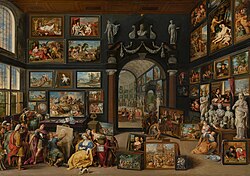

The art of Europe, or Western art, encompasses the history of visual fine art in Europe. European prehistoric fine art started as mobile Upper Paleolithic rock and cave painting and petroglyph fine art and was characteristic of the period betwixt the Paleolithic and the Iron Age.[one] Written histories of European art often brainstorm with the fine art of Ancient Israel and the Ancient Aegean civilizations, dating from the third millennium BC. Parallel with these meaning cultures, art of ane course or another existed all over Europe, wherever there were people, leaving signs such every bit carvings, decorated artifacts and huge standing stones. However a consequent pattern of artistic development within Europe becomes clear only with the fine art of Ancient Greece, adopted and transformed by Rome and carried; with the Roman Empire, across much of Europe, Due north Africa and Western Asia.[two]
The influence of the fine art of the Classical menstruum waxed and waned throughout the next two thousand years, seeming to slip into a distant memory in parts of the Medieval flow, to re-emerge in the Renaissance, endure a menstruation of what some early art historians viewed equally "decay" during the Baroque flow,[three] to reappear in a refined class in Neo-Classicism[4] and to be reborn in Post-Modernism.[five]
Before the 1800s, the Christian church was a major influence upon European art, the commissions of the Church building, architectural, painterly and sculptural, providing the major source of piece of work for artists. The history of the Church was very much reflected in the history of art, during this period. In the same period of time there was renewed interest in heroes and heroines, tales of mythological gods and goddesses, great wars, and baroque creatures which were not connected to religion.[6] Most art of the last 200 years has been produced without reference to religion and frequently with no particular credo at all, but art has frequently been influenced by political problems, whether reflecting the concerns of patrons or the artist.
European art is arranged into a number of stylistic periods, which, historically, overlap each other as different styles flourished in different areas. Broadly the periods are, Classical, Byzantine, Medieval, Gothic, Renaissance, Baroque, Rococo, Neoclassical, Modern, Postmodern and New European Painting.[6]
Prehistoric art [edit]
European prehistoric fine art is an important office of the European cultural heritage.[7] Prehistoric fine art history is unremarkably divided into iv main periods: Stone Age, Neolithic, Bronze Age, and Atomic number 26 Age. Most of the remaining artifacts of this menses are small sculptures and cave paintings.
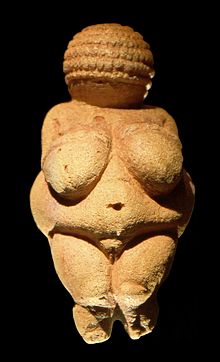
Much surviving prehistoric art is small portable sculptures, with a small group of female Venus figurines such equally the Venus of Willendorf (24,000–22,000 BC) found beyond central Europe;[8] the xxx cm alpine Löwenmensch figurine of about xxx,000 BCE has hardly any pieces that tin be related to information technology. The Swimming Reindeer of about xi,000 BCE is one of the finest of a number of Magdalenian carvings in bone or antler of animals in the art of the Upper Paleolithic, though they are outnumbered by engraved pieces, which are sometimes classified as sculpture.[9] With the showtime of the Mesolithic in Europe figurative sculpture greatly reduced,[ten] and remained a less common element in fine art than relief decoration of applied objects until the Roman menses, despite some works such every bit the Gundestrup cauldron from the European Iron Age and the Bronze Age Trundholm sun chariot.[11]
The oldest European cave fine art dates back 40,800, and can be found in the El Castillo Cave in Kingdom of spain.[12] Other cave painting sites include Lascaux, Cavern of Altamira, Grotte de Cussac, Pech Merle, Cave of Niaux, Chauvet Cavern, Font-de-Gaume, Creswell Crags, Nottinghamshire, England, (Cavern etchings and bas-reliefs discovered in 2003), Coliboaia cave from Romania (considered the oldest cavern painting in cardinal Europe)[13] and Magura,[1] Belogradchik, Bulgaria.[fourteen] Rock painting was likewise performed on cliff faces, but fewer of those accept survived because of erosion. One well-known example is the rock paintings of Astuvansalmi in the Saimaa surface area of Republic of finland. When Marcelino Sanz de Sautuola first encountered the Magdalenian paintings of the Altamira cave, Cantabria, Kingdom of spain in 1879, the academics of the time considered them hoaxes. Recent reappraisals and numerous additional discoveries have since demonstrated their authenticity, while at the same time stimulating interest in the artistry of Upper Palaeolithic peoples. Cavern paintings, undertaken with merely the virtually rudimentary tools, can besides replenish valuable insight into the culture and beliefs of that era.
The Stone art of the Iberian Mediterranean Bowl represents a very different fashion, with the human figure the primary focus, often seen in large groups, with battles, dancing and hunting all represented, besides as other activities and details such as wear. The figures are generally rather sketchily depicted in thin paint, with the relationships betwixt the groups of humans and animals more carefully depicted than individual figures. Other less numerous groups of stone fine art, many engraved rather than painted, evidence similar characteristics. The Iberian examples are believed to appointment from a long menstruation maybe covering the Upper Paleolithic, Mesolithic and early Neolithic.
Prehistoric Celtic art comes from much of Iron Age Europe and survives mainly in the class of high-condition metalwork skillfully busy with complex, elegant and mostly abstract designs, often using curving and spiral forms. There are human heads and some fully represented animals, but total-length human being figures at any size are so rare that their absence may stand for a religious taboo. As the Romans conquered Celtic territories, it almost entirely vanishes, but the mode continued in limited utilise in the British Isles, and with the coming of Christianity revived there in the Insular style of the Early Heart Ages.
Ancient [edit]
Minoan [edit]
The Minoan culture of Crete is regarded as the oldest culture in Europe.[15] Minoan art is marked by imaginative images and infrequent workmanship. Sinclair Hood described an "essential quality of the finest Minoan art, the power to create an atmosphere of motion and life although post-obit a set of highly formal conventions".[16] Information technology forms role of the wider grouping of Aegean art, and in after periods came for a time to accept a ascendant influence over Cycladic art. Forest and textiles take decomposed, so most surviving examples of Minoan art are pottery, intricately-carved Minoan seals, .palace frescos which include landscapes), small sculptures in various materials, jewellery, and metalwork.
The relationship of Minoan art to that of other contemporary cultures and subsequently Ancient Greek fine art has been much discussed. Information technology clearly dominated Mycenaean fine art and Cycladic art of the same periods,[17] fifty-fifty later on Crete was occupied past the Mycenaeans, but only some aspects of the tradition survived the Greek Dark Ages after the collapse of Mycenaean Greece.[eighteen]
Minoan art has a variety of subject-matter, much of information technology appearing across different media, although only some styles of pottery include figurative scenes. Bull-leaping appears in painting and several types of sculpture, and is thought to have had a religious significance; bull's heads are also a popular subject in terracotta and other sculptural materials. There are no figures that announced to be portraits of individuals, or are clearly royal, and the identities of religious figures is often tentative,[19] with scholars uncertain whether they are deities, clergy or devotees.[20] Equally, whether painted rooms were "shrines" or secular is far from articulate; ane room in Akrotiri has been argued to be a bedroom, with remains of a bed, or a shrine.[21]
Animals, including an unusual variety of marine fauna, are often depicted; the "Marine Mode" is a type of painted palace pottery from MM III and LM IA that paints bounding main creatures including octopus spreading all over the vessel, and probably originated from similar frescoed scenes;[22] sometimes these announced in other media. Scenes of hunting and warfare, and horses and riders, are mostly found in later periods, in works maybe fabricated past Cretans for a Mycenaean market, or Mycenaean overlords of Crete.
While Minoan figures, whether human or animal, have a great sense of life and motion, they are often non very accurate, and the species is sometimes impossible to identify; past comparing with Ancient Egyptian fine art they are oftentimes more brilliant, just less naturalistic.[23] In comparison with the art of other aboriginal cultures there is a high proportion of female figures, though the idea that Minoans had only goddesses and no gods is at present discounted. Most human figures are in profile or in a version of the Egyptian convention with the head and legs in contour, and the trunk seen frontally; simply the Minoan figures exaggerate features such as slim male waists and big female person breasts.[24]
-

The Malia Pendant; 1800-1700 BC; golden; height: iv.half-dozen cm, width: 4.ix cm; Heraklion Archaeological Museum
-

The fresco named the Bull-Leaping Fresco; 1675-1460 BC; lime plaster; tiptop: 0.eight m, width: 1 g; from the palace at Knossos (Crete); Heraklion Archaeological Museum
-

"Ophidian Goddess" figurine; 1460-1410 BC (from the Minoan Neo-deluxe Flow); faience; height: 29.5 cm; from the Temple Repository at Knossos; Heraklion Archaeological Museum
Classical Greek and Hellenistic [edit]
Ancient Greece had great painters, great sculptors, and bang-up architects. The Parthenon is an example of their architecture that has lasted to modernistic days. Greek marble sculpture is often described as the highest form of Classical art. Painting on the pottery of Ancient Hellenic republic and ceramics gives a particularly informative glimpse into the way club in Aboriginal Greece functioned. Black-figure vase painting and Red-figure vase painting gives many surviving examples of what Greek painting was. Some famous Greek painters on wooden panels who are mentioned in texts are Apelles, Zeuxis and Parrhasius, however no examples of Ancient Greek panel painting survive, only written descriptions by their contemporaries or by later Romans. Zeuxis lived in v–6 BC and was said to exist the kickoff to apply sfumato. According to Pliny the Elder, the realism of his paintings was such that birds tried to eat the painted grapes. Apelles is described as the greatest painter of Antiquity for perfect technique in drawing, brilliant colour and modeling.
-
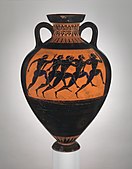
-
-

The Parthenon on the Athenian Acropolis, the most iconic Doric Greek temple built of marble and limestone between circa 460-406 BC, defended to the goddess Athena[25]
-

Mirror with a support in the form of a draped woman; mid-5th century BC; bronze; meridian: 40.41 cm; Metropolitan Museum of Art
-

Calyx-krater; 400-375 BC; ceramic; height: 27.9 cm, diameter: 28.6 cm; from Thebes (Hellenic republic); Louvre
-

-

Statuette of a draped woman; 2nd century BC; terracotta; height: 29.two cm; Metropolitan Museum of Fine art
-

Venus de Milo; 130–100 BC; marble; height: 203 cm (80 in); Louvre
-

Illustrations of examples of ancient Greek ornaments and patterns, fatigued in 1874
Roman [edit]
Roman art was influenced by Greece and tin in part be taken as a descendant of ancient Greek painting and sculpture, but was likewise strongly influenced by the more local Etruscan art of Italia. Roman sculpture, is primarily portraiture derived from the upper classes of society as well as depictions of the gods. However, Roman painting does accept important unique characteristics. Among surviving Roman paintings are wall paintings, many from villas in Campania, in Southern Italy, especially at Pompeii and Herculaneum. Such painting tin be grouped into iv principal "styles" or periods[26] and may contain the outset examples of trompe-50'œil, pseudo-perspective, and pure landscape.[27]
About all of the surviving painted portraits from the Ancient earth are a large number of coffin-portraits of bust form found in the Tardily Antique cemetery of Al-Fayum. They give an idea of the quality that the finest ancient work must have had. A very small-scale number of miniatures from Late Antique illustrated books as well survive, and a rather larger number of copies of them from the Early on Medieval catamenia. Early Christian art grew out of Roman popular, and later Imperial, art and adapted its iconography from these sources.
-

Bronze statuette of a philosopher on a lamp stand up; late 1st century BC; bronze; overall: 27.iii cm; weight: 2.9 kg; Metropolitan Museum of Art (New York City)
-
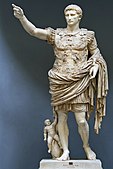
-

Restoration of a fresco from an Ancient villa sleeping accommodation; 50-xl BC; dimensions of the room: 265.4 ten 334 x 583.ix cm; Metropolitan Museum of Fine art (New York City)
-

Altar with festoons; circa 50 Advertising; marble; height: 99.5 cm, width: 61.v cm, depth: 47 cm; Louvre
-

Calyx-krater with reliefs of maidens and dancing maenads; 1st century Advertizement; Pentelic marble; height: 80.seven cm; Metropolitan Museum of Art
-

Panoramic view of the Pantheon (Rome), congenital betwixt 113 and 125
-
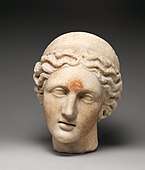
Caput of a goddess wearing a diadem; 1st–2d century; marble; height: 23 cm; Metropolitan Museum of Art
-
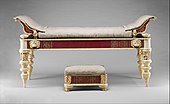
Couch and footstool; 1st–2nd century Ad; forest, bone and glass; couch: 105.iv × 76.two × 214.6 cm; Metropolitan Museum of Art
-
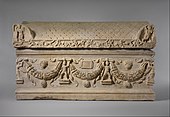
Sarcophagus with festoons; 200–225; marble; 134.6 x 223.5 cm; Metropolitan Museum of Art
Medieval [edit]
Nearly surviving fine art from the Medieval menstruation was religious in focus, often funded by the Church, powerful ecclesiastical individuals such equally bishops, communal groups such as abbeys, or wealthy secular patrons. Many had specific liturgical functions—processional crosses and altarpieces, for instance.
One of the central questions about Medieval art concerns its lack of realism. A neat deal of knowledge of perspective in art and understanding of the human effigy was lost with the autumn of Rome. Simply realism was not the primary concern of Medieval artists. They were simply trying to transport a religious bulletin, a task which demands articulate iconic images instead of precisely rendered ones.
Time Flow: 6th century to 15th century
Early Medieval fine art [edit]
Migration catamenia art is a general term for the art of the "barbarian" peoples who moved into formerly Roman territories. Celtic art in the 7th and 8th centuries saw a fusion with Germanic traditions through contact with the Anglo-Saxons creating what is called the Hiberno-Saxon mode or Insular fine art, which was to be highly influential on the rest of the Centre Ages. Merovingian art describes the art of the Franks before almost 800, when Carolingian art combined insular influences with a cocky-witting classical revival, developing into Ottonian fine art. Anglo-Saxon art is the art of England subsequently the Insular period. Illuminated manuscripts contain nearly all the surviving painting of the menses, but compages, metalwork and pocket-sized carved work in forest or ivory were also important media.
-
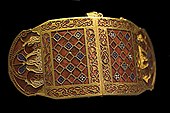
Shoulder-clasps from Sutton Hoo; early on 7th century; gold, glass & garnet; length: 12.7 cm; British Museum
Byzantine [edit]
Byzantine art overlaps with or merges with what nosotros call Early Christian fine art until the iconoclasm period of 730-843 when the vast majority of artwork with figures was destroyed; then little remains that today whatsoever discovery sheds new understanding. Afterwards 843 until 1453 there is a clear Byzantine fine art tradition. It is often the finest art of the Middle Ages in terms of quality of material and workmanship, with production centered on Constantinople. Byzantine fine art'south crowning accomplishment were the monumental frescos and mosaics within domed churches, most of which have not survived due to natural disasters and the cribbing of churches to mosques.
-
-

Gospel lectionary; circa 1100; tempera, gold, and ink on parchment, and leather bounden; overall: 36.eight ten 29.6 x 12.4 cm, folio: 35 x 26.2 cm; Metropolitan Museum of Art (New York City)
Romanesque [edit]
Romanesque fine art refers to the period from almost 1000 to the rise of Gothic fine art in the 12th century. This was a menses of increasing prosperity, and the first to see a coherent style used beyond Europe, from Scandinavia to Sicily. Romanesque fine art is vigorous and directly, was originally brightly coloured, and is often very sophisticated. Stained glass and enamel on metalwork became important media, and larger sculptures in the round adult, although high relief was the principal technique. Its architecture is dominated by thick walls, and round-headed windows and arches, with much carved decoration.
Gothic [edit]
Gothic art is a variable term depending on the craft, place and time. The term originated with Gothic architecture in 1140, only Gothic painting did not announced until around 1200 (this date has many qualifications), when information technology diverged from Romanesque way. Gothic sculpture was born in France in 1144 with the renovation of the Abbey Church building of S. Denis and spread throughout Europe, past the 13th century it had get the international style, replacing Romanesque. International Gothic describes Gothic art from about 1360 to 1430, later on which Gothic art merges into Renaissance fine art at dissimilar times in different places. During this catamenia forms such equally painting, in fresco and on console, become newly important, and the terminate of the menstruum includes new media such as prints.
-

Due north transept windows; circa 1230–1235; stained glass; diameter (rose window): 10.2 m; Chartres Cathedral
-

Scenes from the Legend of Saint Vincent of Saragossa; 1245–1247; pot-metal glass, vitreous paint, and lead; overall: 373.4 x 110.5 cm; Metropolitan Museum of Art (New York City)
-

French diptych with the coronation of the Virgin and the Final Judgment; 1260–1270; elephant ivory with metal mounts; overall: 12.7 10 13 ten 1.ix cm; Metropolitan Museum of Fine art
-

Enthroned Virgin and kid; 1260–1280; elephant ivory with traces of pigment and gilding; overall: 18.4 x vii.vi x 7.iii cm; Metropolitan Museum of Fine art
-

Bifolium with the decretals of gratian; circa 1290; tempera and gold on parchment, brown ink, and modernistic leather binding; overall: 48.3 x 29.2 x i.3 cm, opened: 47.two cm; Metropolitan Museum of Art
-

German language diptych with religious scenes; 1300–1325; silver gilt with translucent and opaque enamels; overall (opened): six.1 x viii.half-dozen x 0.viii cm; Metropolitan Museum of Art
-
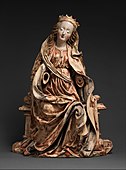
Austrian statue of Enthroned Virgin; 1490–1500; limestone with gesso, painted and aureate; 80.3 x 59.1 x 23.5 cm; Metropolitan Museum of Art
Renaissance [edit]

The Renaissance is characterized by a focus on the arts of Aboriginal Hellenic republic and Rome, which led to many changes in both the technical aspects of painting and sculpture, every bit well as to their subject affair. It began in Italia, a state rich in Roman heritage likewise as fabric prosperity to fund artists. During the Renaissance, painters began to raise the realism of their piece of work by using new techniques in perspective, thus representing iii dimensions more than authentically. Artists also began to apply new techniques in the manipulation of light and darkness, such every bit the tone contrast evident in many of Titian's portraits and the development of sfumato and chiaroscuro by Leonardo da Vinci. Sculptors, too, began to rediscover many aboriginal techniques such as contrapposto. Following with the humanist spirit of the age, fine art became more secular in subject matter, depicting aboriginal mythology in improver to Christian themes. This genre of fine art is ofttimes referred to as Renaissance Classicism. In the North, the well-nigh important Renaissance innovation was the widespread use of oil paints, which allowed for greater color and intensity.
From Gothic to the Renaissance [edit]
During the tardily 13th century and early 14th century, much of the painting in Italy was Byzantine in character, notably that of Duccio of Siena and Cimabue of Florence, while Pietro Cavallini in Rome was more Gothic in fashion. During the 13th century, Italian sculptors began to draw inspiration not simply from medieval prototypes, but as well from ancient works.[30]
In 1290, Giotto began painting in a fashion that was less traditional and more based upon observation of nature. His famous wheel at the Scrovegni Chapel, Padua, is seen equally the beginnings of a Renaissance way.
Other painters of the 14th century were carried the Gothic style to nifty elaboration and detail. Notable amid these painters are Simone Martini and Gentile da Fabriano.
In the Netherlands, the technique of painting in oils rather than tempera, led itself to a form of elaboration that was not dependent upon the application of gilt leaf and embossing, but upon the infinitesimal depiction of the natural world. The art of painting textures with great realism evolved at this fourth dimension. Dutch painters such as Jan van Eyck and Hugo van der Goes were to have nifty influence on Late Gothic and Early Renaissance painting.
Early Renaissance [edit]
The ideas of the Renaissance first emerged in the urban center-state of Florence, Italy. The sculptor Donatello returned to classical techniques such as contrapposto and classical subjects like the unsupported nude—his second sculpture of David was the first free-standing statuary nude created in Europe since the Roman Empire. The sculptor and architect Brunelleschi studied the architectural ideas of ancient Roman buildings for inspiration. Masaccio perfected elements similar composition, individual expression, and human course to paint frescoes, peculiarly those in the Brancacci Chapel, of surprising elegance, drama, and emotion.
A remarkable number of these major artists worked on different portions of the Florence Cathedral. Brunelleschi's dome for the cathedral was one of the offset truly revolutionary architectural innovations since the Gothic flying buttress. Donatello created many of its sculptures. Giotto and Lorenzo Ghiberti besides contributed to the cathedral.
High Renaissance [edit]
High Renaissance artists include such figures equally Leonardo da Vinci, Michelangelo Buonarroti, and Raffaello Sanzio.
The 15th-century creative developments in Italy (for example, the interest in perspectival systems, in depicting beefcake, and in classical cultures) matured during the 16th century, accounting for the designations "Early on Renaissance" for the 15th century and "High Renaissance" for the 16th century. Although no singular style characterizes the Loftier Renaissance, the art of those near closely associated with this flow—Leonardo da Vinci, Raphael, Michelangelo, and Titian—exhibits an astounding mastery, both technical and artful. High Renaissance artists created works of such authority that generations of later artists relied on these artworks for instruction. These exemplary artistic creations further elevated the prestige of artists. Artists could claim divine inspiration, thereby raising visual art to a status formerly given only to poetry. Thus, painters, sculptors, and architects came into their ain, successfully claiming for their work a high position among the fine arts. In a sense, 16th- century masters created a new profession with its own rights of expression and its own venerable grapheme.
Northern art up to the Renaissance [edit]
Early Netherlandish painting developed (but did non strictly invent) the technique of oil painting to allow greater control in painting minute detail with realism—Jan van Eyck (1366–1441) was a figure in the movement from illuminated manuscripts to panel paintings.
Hieronymus Bosch (1450?–1516), a Dutch painter, is some other important figure in the Northern Renaissance. In his paintings, he used religious themes, but combined them with grotesque fantasies, colorful imagery, and peasant folk legends. His paintings oft reflect the confusion and anguish associated with the end of the Eye Ages.
Albrecht Dürer introduced Italian Renaissance way to Deutschland at the end of the 15th century, and dominated German Renaissance art.
Time Period:
- Italian Renaissance: Late 14th century to Early on 16th century
- Northern Renaissance: 16th century
Mannerism, Bizarre, and Rococo [edit]
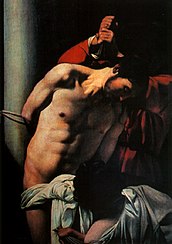
Baroque art was characterised past strongly religious and political themes; common characteristics included rich colours with a strong lite and night contrast. Paintings were elaborate, emotional and dramatic in nature. In the image Caravaggio's Christ at the Cavalcade (Cristo alla colonna)

Rococo art was characterised by lighter, often jocular themes; mutual characteristics included pale, creamy colours, florid decorations and a penchant for bucolic landscapes. Paintings were more ornate than their Baroque analogue, and usually svelte, playful and light-hearted in nature.
In European art, Renaissance Classicism spawned 2 unlike movements—Mannerism and the Baroque. Mannerism, a reaction against the idealist perfection of Classicism, employed distortion of light and spatial frameworks in order to emphasize the emotional content of a painting and the emotions of the painter. The work of El Greco is a particularly clear example of Mannerism in painting during the late 16th, early 17th centuries. Northern Mannerism took longer to develop, and was largely a movement of the last half of the 16th century. Bizarre art took the representationalism of the Renaissance to new heights, emphasizing detail, motility, lighting, and drama in their search for beauty. Perhaps the best known Baroque painters are Caravaggio, Rembrandt, Peter Paul Rubens, and Diego Velázquez.
A rather different art developed out of northern realist traditions in 17th-century Dutch Golden Age painting, which had very fiddling religious art, and little history painting, instead playing a crucial part in developing secular genres such as yet life, genre paintings of everyday scenes, and landscape painting. While the Baroque nature of Rembrandt's art is articulate, the label is less use for Vermeer and many other Dutch artists. Flemish Bizarre painting shared a part in this trend, while likewise continuing to produce the traditional categories.
Baroque fine art is oft seen as function of the Counter-Reformation—the artistic element of the revival of spiritual life in the Roman Cosmic Church. Additionally, the emphasis that Baroque art placed on grandeur is seen every bit Absolutist in nature. Religious and political themes were widely explored within the Baroque artistic context, and both paintings and sculptures were characterised by a strong element of drama, emotion and theatricality. Famous Baroque artists include Caravaggio or Rubens.[34] Artemisia Gentileschi was another noteworthy artist, who was inspired by Caravaggio's style. Baroque art was particularly ornate and elaborate in nature, often using rich, warm colours with night undertones. Pomp and grandeur were important elements of the Baroque artistic motion in general, equally can be seen when Louis Fourteen said, "I am grandeur incarnate"; many Baroque artists served kings who tried to realize this goal. Baroque art in many ways was similar to Renaissance art; as a matter of fact, the term was initially used in a derogative style to draw postal service-Renaissance art and architecture which was over-elaborate.[34] Bizarre art tin be seen every bit a more elaborate and dramatic re-adaptation of belatedly Renaissance art.
By the 18th century, yet, Bizarre art was falling out of fashion as many deemed it too melodramatic and also gloomy, and it developed into the Rococo, which emerged in France. Rococo art was fifty-fifty more elaborate than the Baroque, but information technology was less serious and more playful.[35] Whilst the Baroque used rich, strong colours, Rococo used pale, creamier shades. The artistic movement no longer placed an emphasis on politics and religion, focusing instead on lighter themes such as romance, celebration, and appreciation of nature. Rococo art as well contrasted the Baroque equally it oftentimes refused symmetry in favor of asymmetrical designs. Furthermore, it sought inspiration from the creative forms and ornament of Far Eastern asia, resulting in the rise in favour of porcelain figurines and chinoiserie in full general.[36] The 18th-century style flourished for a short while; nevertheless, the Rococo style before long savage out of favor, existence seen by many as a gaudy and superficial motion emphasizing aesthetics over meaning. Neoclassicism in many ways developed as a counter movement of the Rococo, the impetus being a sense of disgust directed towards the latter'south florid qualities.
Mannerism (16th century) [edit]
Baroque (early 17th century to mid-early on 18th century) [edit]
-

-
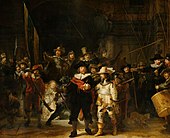
-
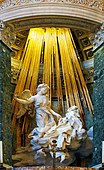
-

The Bosom of Louis 14; by Gian Lorenzo Bernini; 1665; marble; 105 × 99 × 46 cm; Palace of Versailles
-

Carpeting with fame and fortitude; 1668–1685; knotted and cut wool pile, woven with well-nigh xc knots per foursquare inch; 909.3 10 459.vii cm; Metropolitan Museum of Art
-

Rococo (early to mid-18th century) [edit]
-

Boiserie from the Hôtel de Varengeville; circa 1736–1752; various materials, including carved, painted, and gilded oak; height: v.58 m, width: 7.07 m, length: 12.36 yard; in the Metropolitan Museum of Art (New York Urban center)
-

Championship impress; by Juste Meissonnier; 1738–1749; etching on paper; 51.half-dozen 10 34.9 cm; Rijksmuseum
-

Pair of candelabrums; 18th century; soft-paste porcelain; heights (the left i): 26.viii cm, (the correct one): 26.4 cm; past the Chelsea porcelain factory; Metropolitan Museum of Art
-

Neoclassicism, Romanticism, Academism, and Realism [edit]

Throughout the 18th century, a counter movement opposing the Rococo sprang up in unlike parts of Europe, commonly known equally Neoclassicism. It despised the perceived superficiality and frivolity of Rococo art, and desired for a render to the simplicity, order and 'purism' of classical antiquity, especially ancient Hellenic republic and Rome. The move was in office as well influenced past the Renaissance, which itself was strongly influenced by classical fine art. Neoclassicism was the artistic component of the intellectual movement known equally the Enlightenment; the Enlightenment was idealistic, and put its accent on objectivity, reason and empirical truth. Neoclassicism had go widespread in Europe throughout the 18th century, particularly in the United Kingdom, which saw keen works of Neoclassical architecture spring up during this flow; Neoclassicism's fascination with classical antiquity tin be seen in the popularity of the Grand Bout during this decade, where wealthy aristocrats travelled to the ancient ruins of Italy and Greece. Notwithstanding, a defining moment for Neoclassicism came during the French Revolution in the late 18th century; in France, Rococo art was replaced with the preferred Neoclassical art, which was seen as more serious than the quondam movement. In many ways, Neoclassicism can be seen every bit a political motility every bit well as an artistic and cultural i.[37] Neoclassical art places an emphasis on social club, symmetry and classical simplicity; common themes in Neoclassical fine art include courage and war, every bit were commonly explored in aboriginal Greek and Roman art. Ingres, Canova, and Jacques-Louis David are amidst the best-known neoclassicists.[38]
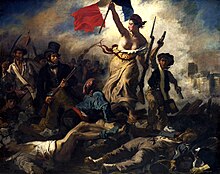
Just as Mannerism rejected Classicism, so did Romanticism reject the ideas of the Enlightenment and the aesthetic of the Neoclassicists. Romanticism rejected the highly objective and ordered nature of Neoclassicism, and opted for a more individual and emotional approach to the arts.[39] Romanticism placed an emphasis on nature, particularly when aiming to portray the power and beauty of the natural world, and emotions, and sought a highly personal approach to art. Romantic art was nearly individual feelings, not common themes, such every bit in Neoclassicism; in such a way, Romantic art often used colours in order to express feelings and emotion.[39] Similarly to Neoclassicism, Romantic art took much of its inspiration from ancient Greek and Roman art and mythology, however, unlike Neoclassical, this inspiration was primarily used as a mode to create symbolism and imagery. Romantic fine art also takes much of its aesthetic qualities from medievalism and Gothicism, also as mythology and folklore. Amongst the greatest Romantic artists were Eugène Delacroix, Francisco Goya, J.One thousand.W. Turner, John Constable, Caspar David Friedrich, Thomas Cole, and William Blake.[38]
Most artists attempted to take a centrist approach which adopted different features of Neoclassicist and Romanticist styles, in order to synthesize them. The different attempts took place within the French Academy, and collectively are called Academic art. Adolphe William Bouguereau is considered a chief example of this stream of art.
In the early 19th century the face of Europe, however, became radically altered by industrialization. Poverty, squalor, and desperation were to be the fate of the new working class created by the "revolution". In response to these changes going on in lodge, the movement of Realism emerged. Realism sought to accurately portray the conditions and hardships of the poor in the hopes of irresolute society. In contrast with Romanticism, which was essentially optimistic almost mankind, Realism offered a stark vision of poverty and despair. Similarly, while Romanticism glorified nature, Realism portrayed life in the depths of an urban wasteland. Similar Romanticism, Realism was a literary equally well as an artistic movement. The great Realist painters include Jean-Baptiste-Siméon Chardin, Gustave Courbet, Jean-François Millet, Camille Corot, Honoré Daumier, Édouard Manet, Edgar Degas (both considered every bit Impressionists), and Thomas Eakins, amid others.
The response of architecture to industrialisation, in stark contrast to the other arts, was to veer towards historicism. Although the railway stations built during this catamenia are frequently considered the truest reflections of its spirit – they are sometimes called "the cathedrals of the age" – the main movements in architecture during the Industrial Historic period were revivals of styles from the distant by, such as the Gothic Revival. Related movements were the Pre-Raphaelite Brotherhood, who attempted to return fine art to its state of "purity" prior to Raphael, and the Arts and Crafts Motion, which reacted against the impersonality of mass-produced goods and advocated a return to medieval craftsmanship.
Fourth dimension Menstruum:
- Neoclassicism: mid-early 18th century to early on 19th century
- Romanticism: late 18th century to mid-19th century
- Realism: 19th century
Modern art [edit]
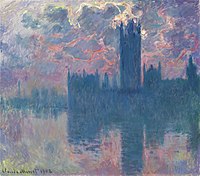

Out of the naturalist ethic of Realism grew a major creative movement, Impressionism. The Impressionists pioneered the use of light in painting as they attempted to capture light as seen from the human heart. Edgar Degas, Édouard Manet, Claude Monet, Camille Pissarro, and Pierre-Auguste Renoir, were all involved in the Impressionist movement. Every bit a straight outgrowth of Impressionism came the evolution of Post-Impressionism. Paul Cézanne, Vincent van Gogh, Paul Gauguin, Georges Seurat are the best known Post-Impressionists.
Following the Impressionists and the Post-Impressionists came Fauvism, frequently considered the kickoff "modern" genre of fine art. Just as the Impressionists revolutionized low-cal, and then did the fauvists rethink color, painting their canvases in vivid, wild hues. Later the Fauvists, mod art began to develop in all its forms, ranging from Expressionism, concerned with evoking emotion through objective works of art, to Cubism, the art of transposing a 4-dimensional reality onto a apartment canvas, to Abstract art. These new fine art forms pushed the limits of traditional notions of "art" and corresponded to the like rapid changes that were taking identify in human society, applied science, and thought.
Surrealism is often classified as a course of Mod Art. However, the Surrealists themselves accept objected to the study of surrealism equally an era in art history, claiming that it oversimplifies the complexity of the motility (which they say is not an artistic motility), misrepresents the relationship of surrealism to aesthetics, and falsely characterizes ongoing surrealism every bit a finished, historically encapsulated era. Other forms of Modern art (some of which border on Contemporary art) include:
- Abstract expressionism
- Art Deco
- Fine art Nouveau
- Bauhaus
- Color Field painting
- Conceptual Art
- Constructivism
- Cubism
- Dada
- Der Blaue Reiter
- De Stijl
- Die Brücke
- Torso Art
- Expressionism
- Fauvism
- Fluxus
- Futurism
- Happening
- Surrealism
- Lettrisme
- Lyrical Brainchild
- State Art
- Minimalism
- Naive art
- Op art
- Performance art
- Photorealism
- Pop art
- Suprematism
- Video art
- Vorticism
Time Menstruum:
- Impressionism: late 19th Century
- Others: First one-half of the 20th century
Contemporary fine art and Postmodern art [edit]

Modernistic art foreshadowed several characteristics of what would later exist divers every bit postmodern fine art; as a affair of fact, several mod art movements tin ofttimes be classified equally both mod and postmodern, such equally pop art. Postmodern art, for example, places a stiff accent on irony, parody and humour in general; modern art started to develop a more ironic arroyo to art which would later advance in a postmodern context. Postmodern fine art sees the blurring between the loftier and fine arts with low-end and commercial art; modern fine art started to experiment with this blurring.[39] Contempo developments in fine art have been characterised by a significant expansion of what tin now deemed to be art, in terms of materials, media, action and concept. Conceptual art in item has had a broad influence. This started literally every bit the replacement of concept for a fabricated object, one of the intentions of which was to refute the commodification of art. However, it at present normally refers to an artwork where at that place is an object, simply the main merits for the work is fabricated for the idea process that has informed it. The aspect of commercialism has returned to the work.
There has too been an increase in art referring to previous movements and artists, and gaining validity from that reference.
Postmodernism in art, which has grown since the 1960s, differs from Modernism in as much equally Modern fine art movements were primarily focused on their ain activities and values, while Postmodernism uses the whole range of previous movements equally a reference point. This has by definition generated a relativistic outlook, accompanied by irony and a certain disbelief in values, as each can be seen to be replaced past another. Another effect of this has been the growth of capitalism and celebrity. Postmodern art has questioned mutual rules and guidelines of what is regarded as 'fine art', merging low art with the fine arts until none is fully distinguishable.[40] [41] Before the appearance of postmodernism, the fine arts were characterised by a form of artful quality, elegance, craftsmanship, finesse and intellectual stimulation which was intended to appeal to the upper or educated classes; this distinguished loftier fine art from low art, which, in turn, was seen every bit tacky, kitsch, easily made and lacking in much or whatever intellectual stimulation, art which was intended to appeal to the masses. Postmodern art blurred these distinctions, bringing a stiff chemical element of kitsch, commercialism and campness into contemporary art;[39] what is nowadays seen as fine art may have been seen equally low fine art earlier postmodernism revolutionised the concept of what high or fine art truly is.[39] In addition, the postmodern nature of gimmicky fine art leaves a lot of space for individualism within the fine art scene; for instance, postmodern art oftentimes takes inspiration from by artistic movements, such as Gothic or Baroque art, and both juxtaposes and recycles styles from these past periods in a different context.[39]
Some surrealists in particular Joan Miró, who chosen for the "murder of painting" (In numerous interviews dating from the 1930s onwards, Miró expressed contempt for conventional painting methods and his desire to "kill", "murder", or "rape" them in favor of more gimmicky means of expression).[42] have denounced or attempted to "supersede" painting, and there take as well been other anti-painting trends amongst creative movements, such as that of Dada and conceptual art. The trend away from painting in the tardily 20th century has been countered by various movements, for example the continuation of Minimal Art, Lyrical Abstraction, Pop Art, Op Art, New Realism, Photorealism, Neo Geo, Neo-expressionism, New European Painting, Stuckism, Excessivism and various other important and influential painterly directions.
Come across as well [edit]
- History of art
- History of painting
- Lives of the Most Fantabulous Painters, Sculptors, and Architects (16th century book)
- Modernism
- Painting in the Americas earlier European colonization
- Western European paintings in Ukrainian museums
- List of time periods
References [edit]
- ^ a b Oosterbeek, Luíz. "European Prehistoric Art". Europeart . Retrieved iv December 2012.
- ^ Boardman, John ed., The Oxford History of Classical Art, pp. 349-369, Oxford University Press, 1993, ISBN 0198143869
- ^ Banister Fletcher excluded well-nigh all Baroque buildings from his mammoth tome A History of Architecture on the Comparative Method. The publishers somewhen rectified this.
- ^ Murray, P. and Murray, L. (1963) The Art of the Renaissance. London: Thames & Hudson (World of Art), p. ix. ISBN 978-0-500-20008-7. "...in 1855 we find, for the first time, the discussion 'Renaissance' used — past the French historian Michelet — as an adjective to describe a whole menses of history and not confined to the rebirth of Latin letters or a classically inspired style in the arts."
- ^ Hause, S. & Maltby, W. (2001). A History of European Society. Essentials of Western Civilisation (Vol. 2, pp. 245–246). Belmont, CA: Thomson Learning, Inc.
- ^ a b "Art of Europe". Saint Louis Art Museum. Slam. Retrieved 4 December 2012.
- ^ Oosterbeek, Luíz. "European Prehistoric Fine art". Europeart . Retrieved 4 December 2012.
- ^ Sandars, 8-xvi, 29-31
- ^ Hahn, Joachim, "Prehistoric Europe, §Two: Palaeolithic 3. Portable art" in Oxford Art Online, accessed 24 August 2012; Sandars, 37-xl
- ^ Sandars, 75-80
- ^ Sandars, 253-257, 183-185
- ^ Kwong, Matt. "Oldest cave-man fine art in Europe dates back 40,800 years". CBC News. Retrieved four December 2012.
- ^ "Romanaian Cavern May Boast Central Europe'southward Oldest Cavern Art | Science/AAAS | News". News.sciencemag.org. 21 June 2010. Retrieved 25 Baronial 2013.
- ^ Gunther, Michael. "Art of Prehistoric Europe". Retrieved iv Dec 2012.
- ^ Chaniotis, Angelos. "Ancient Crete". Oxford Bibliographies. Oxford University Printing. Retrieved ii January 2013.
- ^ Hood, 56
- ^ Hood, 17-18, 23-23
- ^ Hood, 240-241
- ^ Gates (2004), 33-34, 41
- ^ eg Hood, 53, 55, 58, 110
- ^ Chapin, 49-51
- ^ Hood, 37-38
- ^ Hood, 56, 233-235
- ^ Hood, 235-236
- ^ Mattinson, Lindsay (2019). Agreement Architecture A Guide To Architectural Styles. Bister Books. p. 21. ISBN978-one-78274-748-2.
- ^ "Roman Painting". Art-and-archaeology.com. Retrieved 25 Baronial 2013.
- ^ "Roman Painting". Heilbrunn Timeline of Fine art History. The Metropolitan Museum of Art. Retrieved nineteen October 2013.
- ^ "The Vitruvian Man". leonardodavinci.stanford.edu . Retrieved 25 March 2018.
- ^ a b "BBC - Scientific discipline & Nature - Leonardo - Vitruvian human". www.bbc.co.uk . Retrieved 25 March 2018.
- ^ Fortenberry, Diane (2017). THE ART MUSEUM. Phaidon. p. 156. ISBN978 0 7148 7502 6.
- ^ Fortenberry, Diane (2017). THE Art MUSEUM. Phaidon. p. 156. ISBN978 0 7148 7502 six.
- ^ Fortenberry, Diane (2017). THE Fine art MUSEUM. Phaidon. p. 157. ISBN978 0 7148 7502 6.
- ^ Fortenberry, Diane (2017). THE Art MUSEUM. Phaidon. p. 157. ISBN978 0 7148 7502 6.
- ^ a b "Bizarre Fine art". Arthistory-famousartists-paintings.com. 24 July 2013. Retrieved 25 August 2013.
- ^ "Ancien Regime Rococo". Bc.edu. Archived from the original on 11 April 2018. Retrieved 25 Baronial 2013.
- ^ "chinoiserie facts, information, pictures - Encyclopedia.com manufactures about chinoiserie". www.encyclopedia.com . Retrieved 25 March 2018.
- ^ "Art in Neoclassicism". Artsz.org. 26 February 2008. Retrieved 25 Baronial 2013.
- ^ a b James J. Sheehan, "Art and Its Publics, c. 1800," United and Diversity in European Culture c. 1800, ed. Tim Blanning and Hagen Schulze (New York: Oxford Academy Press, 2006), 5-eighteen.
- ^ a b c d due east f "General Introduction to Postmodernism". Cla.purdue.edu. Retrieved 25 August 2013.
- ^ Ideas About Art, Desmond, Kathleen K. [1] John Wiley & Sons, 2011, p.148
- ^ International postmodernism: theory and literary practice, Bertens, Hans [ii], Routledge, 1997, p.236
- ^ M. Rowell, Joan Mirό: Selected Writings and Interviews (London: Thames & Hudson, 1987) pp. 114–116.
Bibliography [edit]
- Chapin, Anne P., "Power, Privilege and Landscape in Minoan Fine art", in Charis: Essays in Honor of Sara A. Immerwahr, Hesperia (Princeton, N.J.) 33, 2004, ASCSA, ISBN 0876615337, 9780876615331, google books
- Gates, Charles, "Pictorial Imagery in Minoan Wall Painting", in Charis: Essays in Honor of Sara A. Immerwahr, Hesperia (Princeton, Due north.J.) 33, 2004, ASCSA, ISBN 0876615337, 9780876615331, google books
- Hood, Sinclair, The Arts in Prehistoric Hellenic republic, 1978, Penguin (Penguin/Yale History of Art), ISBN 0140561420
- Sandars, Nancy Thousand., Prehistoric Art in Europe, Penguin (Pelican, at present Yale, History of Fine art), 1968 (nb 1st edn.; early datings now superseded)
External links [edit]
- Web Gallery of Art
- Postmodernism
- European artists community
- Panopticon Virtual Fine art Gallery
Source: https://en.wikipedia.org/wiki/Art_of_Europe


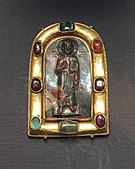






0 Response to "Reflects the Revival of Classical Themes in European Art"
Post a Comment